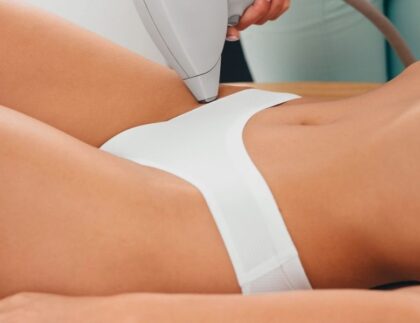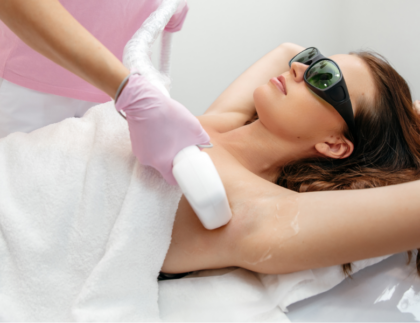
Ingrown hairs are a frustrating and often painful skin concern, especially for those with coarse or curly hair. Whether it’s from shaving, waxing, or plucking, the aftermath can lead to redness, bumps, and even infections. Over time, repeated hair removal can worsen the issue, causing inflammation and skin discoloration. People often search for long-term solutions to avoid the cycle of irritation, and one question continues to surface: Can laser hair removal get rid of ingrown hairs too?
The short answer is yes, but understanding how and why takes a closer look at how laser technology works. For those searching for a reliable and lasting option like laser hair removal near Vienna, VA, knowing the benefits beyond smoother skin makes a big difference. Laser treatments don’t just reduce hair—they also target the source of ingrown hairs by permanently reducing the root cause. That’s why many dermatologists and cosmetic experts recommend it for individuals who frequently suffer from ingrown hair problems.
Let’s take a closer look at what really happens during laser hair removal and how it affects ingrown hairs over time.
What Causes Ingrown Hairs?
Ingrown hairs form when a hair curls back or grows sideways into the skin. This is more common in areas frequently shaved or waxed, like the legs, underarms, bikini line, or face. When the hair doesn’t emerge through the skin properly, it creates a small bump that may become red, inflamed, or infected. Certain skin types and hair textures—particularly those with thick or curly hair—are more prone to experiencing this.
Improper shaving techniques, tight clothing, and frequent hair removal increase the likelihood of developing ingrown hairs. While exfoliation and topical treatments may help, they often provide only temporary relief.
How Laser Hair Removal Works
Laser hair removal uses concentrated light energy to target melanin (pigment) in the hair follicle. This energy heats and damages the follicle, eventually reducing or stopping future hair growth. The process is precise, targeting only the hair root without affecting surrounding skin. Over a series of sessions, the treatment significantly reduces both the number and thickness of hairs in the treated area.
As hair growth diminishes, so does the risk of hairs becoming trapped beneath the skin. This is the key reason laser hair removal is so effective at preventing ingrown hairs in the long run.
Does Laser Hair Removal Treat Existing Ingrown Hairs?
Laser treatments are not specifically designed to treat active ingrown hairs like a topical cream or extraction would. However, the heat from the laser can help destroy the follicle of the trapped hair, reducing inflammation and helping the area heal. Over time, with repeated sessions, the overall number of ingrown hairs decreases significantly.
For individuals dealing with recurring painful bumps, laser hair removal offers a proactive solution that treats the cause rather than just the symptoms.
Who Benefits Most from Laser Hair Removal for Ingrown Hairs?
Those with thick, curly, or coarse hair often find the greatest relief from ingrown hairs through laser hair removal. It’s particularly helpful in areas where friction or shaving is common, such as the bikini line, underarms, and jawline.
People who are prone to razor burn, folliculitis, or hyperpigmentation caused by ingrown hairs also see improvements not just in hair reduction but in overall skin clarity and texture.
Is It Safe for All Skin Types?
Advancements in laser technology have made treatments safer and more effective for a wider range of skin tones. However, results can vary depending on the contrast between skin and hair color. Individuals with lighter skin and darker hair typically respond best, but newer devices can accommodate darker skin tones as well.
It’s important to consult with a licensed technician who understands how to customize the treatment based on your unique skin and hair profile to ensure the safest and most effective results.
How Many Sessions Are Needed?
On average, 6 to 8 sessions are needed for optimal results, spaced several weeks apart to match the hair growth cycle. Ingrown hairs usually begin to fade or disappear within the first few treatments as the number of active follicles decreases.
Maintenance sessions once or twice a year may be recommended to keep the area smooth and ingrown-free, especially for areas with persistent growth.
Post-Treatment Care to Prevent Ingrown Hairs
After laser treatment, the skin can be sensitive. Avoiding heat, friction, and tight clothing helps prevent irritation. Gentle exfoliation between treatments can also keep skin clear and encourage remaining hairs to shed naturally.
Hydration, SPF, and mild skincare products support healing and reduce the risk of pigmentation or bumps, making aftercare an essential part of the long-term benefits.
Laser hair removal offers more than just smoother skin—it provides real relief for those struggling with the discomfort and appearance of ingrown hairs. By targeting the hair follicle at the source, this treatment can break the cycle of irritation and help the skin recover. Whether you’ve been dealing with razor bumps for years or are simply tired of the constant upkeep, laser hair removal is a scientifically backed option with long-term benefits.
If you’re looking for laser hair removal near Vienna, VA, Denude offers expert-led treatments that prioritize safety, comfort, and real results. Schedule a consultation today to get started.









